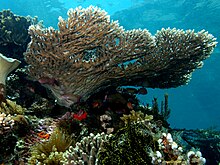Hexacorallia
| Hexacorallia | |
|---|---|

| |
| A stony coral, Acropora latistella | |
| Scientific classification | |
| Domain: | Eukaryota |
| Kingdom: | Animalia |
| Phylum: | Cnidaria |
| Class: | Anthozoa |
| Subclass: | Hexacorallia |
| Orders | |


Hexacorallia is a large subclass of Anthozoa in the aquatic phylum Cnidaria.
It has about 4,300 species, all polyps, generally with 6-fold symmetry. It includes all the stony corals, most of which are colonial and reef-forming. It also contains the sea anemones, tube anemones, and zoanthids, in six living orders.[2]
The Hexacorallia are distinguished from the other subclass of Anthozoa, the Octocorallia, because they have six or less axes of symmetry in their body structure and only single rows of tentacles. They are formed of individual soft polyps which in some species live in colonies and secrete a calcite skeleton. As with all Cnidarians, these organisms have a complex life cycle including a mobile planktonic phase and a later sessile phase.
Hexacorallia also include the extinct orders of the rugose corals and tabulate corals. They built the coral reefs of the Palaeozoic era. In fact, there are a total of eight extinct orders of the Hexacorallia, which shows it has always been an important group of marine organisms.[3]
References[change | change source]
- ↑ Han, Jian; Kubota, Shin; Uchida, Hiro-omi; Stanley Jr., George D.; Yao, Xiaoyong; Shu, Degan; Li, Yong; Yasui, Kinya (October 13, 2010). "Tiny Sea Anemone from the Lower Cambrian of China". PLOS ONE. 5 (10): e13276. Bibcode:2010PLoSO...513276H. doi:10.1371/journal.pone.0013276. PMC 2954142. PMID 20967244.
- ↑ Daly M. et al 2007. The phylum Cnidaria: a review of phylogenetic patterns and diversity 300 years after Linnaeus. Zootaxa, 1668: 127–182, Wellington. Abstract - PDF
- ↑ Stanley G.D.J. (ed) 1996. Paleobiology and biology of corals. Columbus, Ohio: The Paleontological Society.
